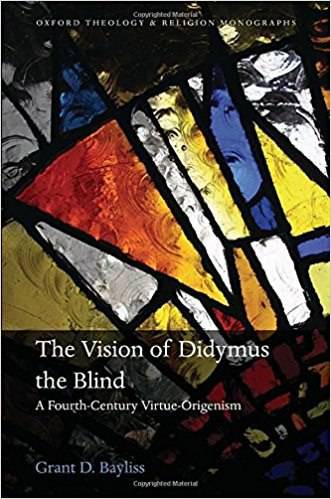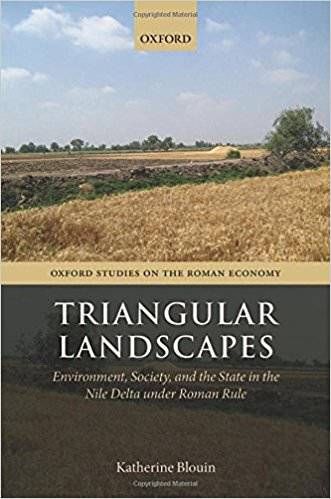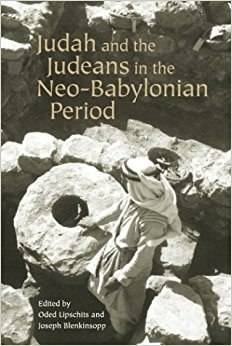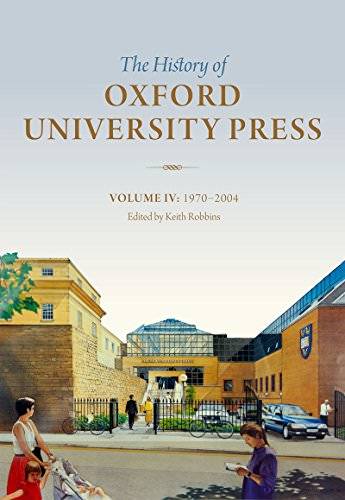Grant D. Bayliss, “The Vision of Didymus the Blind: A Fourth-Century Virtue-Origenism”
Stephen J. C. Andes, “The Vatican and Catholic Activism in Mexico and Chile The Politics of Transnational Catholicism, 1920-1940”
Katherine Blouin, “Triangular Landscapes: Environment, Society, and the State in the Nile Delta under Roman Rule”
Oded Lipschitz, Joseph Blenkinsopp, “Judah and the Judeans in the Neo-Babylonian Period”
The History of Oxford University Press: Volume IV: 1970 to 2004 by Keith Robbins
Grant D. Bayliss, “The Vision of Didymus the Blind: A Fourth-Century Virtue-Origenism”
An independent teacher, based in Alexandria throughout the second half of the fourth century, Didymus appealed to many within the broadly Origenist currents of Egyptian asceticism, including Jerome, Rufinus, and Evagrius. His commentaries, lecture-notes, and theological treatises show him specifically committed to the legacy of Origen and Philo, rather than a broader ‘Alexandrian’ or noetic reading of Scripture. Yet his concern was not to answer classic ‘Antiochene’ critique but rather offer a faithful continuation of many aspects of Origen’s thought and exegesis, now made consistent with the broader anti-subordinationist developments in Nicene faith from the 350s onwards. In doing so he made virtue a primary category of reality, human existence, and life, in ways that go beyond the traditional philosophical tropes.
This ‘turn to virtue’ draws parallels with wider fourth-century trends but it sets Didymus’ own Origenism apart from those of other Origenists, such as Eusebius of Caesarea or Evagrius of Pontus. Thus detailed discussion focuses on Didymus’ portrayal of virtue, sin, and passion, which together form the constant hermeneutical terrain for his anagogical exegesis and exhortation to a dynamic process of ascent. Speculative comments of Origen on the pre-existence of the soul, salvation of the devil, pre-passion, and the sin of Adam are shown to be reframed, both to aid the individual’s navigation of the return to virtue and to answer the challenge of contemporary Manichaean and Apollinarian beliefs.
Stephen J. C. Andes, “The Vatican and Catholic Activism in Mexico and Chile The Politics of Transnational Catholicism, 1920-1940”
As in Europe, secular nation building in Latin America challenged the traditional authority of the Roman Catholic Church in the early twentieth century. In response, Catholic social and political movements sought to contest state-led secularisation and provide an answer to the ‘social question’, the complex set of problems associated with urbanisation, industrialisation, and poverty. As Catholics mobilised against the secular threat, they also struggled with each other to define the proper role of the Church in the public sphere. This study utilizes recently opened files at the Vatican pertaining to Mexico’s post-revolutionary Church-state conflict known as the Cristero Rebellion (1926-1929). However, looking beyond Mexico’s exceptional case, the work employs a transnational framework, enabling a better understanding of the supranational relationship between Latin American Catholic activists and the Vatican. To capture this world historical context, Andes compares Mexico to Chile’s own experience of religious conflict. Unlike past scholarship, which has focused almost exclusively on local conditions, Andes seeks to answer how diverse national visions of Catholicism responded to papal attempts to centralize its authority and universalize Church practices worldwide.
The Politics of Transnational Catholicism applies research on the interwar papacy, which is almost exclusively European in outlook, to a Latin American context. The national cases presented illuminate how Catholicism shaped public life in Latin America as the Vatican sought to define Catholic participation in Mexican and Chilean national politics. It reveals that Catholic activism directly influenced the development of new political movements such as Christian Democracy, which remained central to political life in the region for the remainder of the twentieth century.
Katherine Blouin, “Triangular Landscapes: Environment, Society, and the State in the Nile Delta under Roman Rule”
Between the Roman annexation of Egypt and the Arab period, the Nile Delta went from consisting of seven branches to two, namely the current Rosetta and Damietta branches. For historians, this may look like a slow process, but on a geomorphological scale, it is a rather fast one. How did it happen? How did human action contribute to the phenomenon? Why did it start around the Roman period? And how did it impact on ancient Deltaic communities? This volume reflects on these questions by focusing on a district of the north-eastern Delta called the Mendesian Nome.
The Mendesian Nome is one of the very few Deltaic zones documented by a significant number of papyri. To date, this documentation has never been subject to a comprehensive study. Yet it provides us with a wealth of information on the region’s landscape, administrative geography, and agrarian economy. Starting from these papyri and from all available evidence, this volume investigates the complex networks of relationships between Mendesian environments, socio-economic dynamics, and agro-fiscal policies. Ultimately, it poses the question of the ‘otherness’ of the Nile Delta, within Egypt and, more broadly, the Roman Empire. Section I sets the broader hydrological, documentary, and historical contexts from which the Roman-period Mendesian evidence stem. Section II is dedicated to the reconstruction of the Mendesian landscape, while section III examines the strategies of diversification and the modes of valorization of marginal land attested in the nome. Finally, section IV analyses the socio-environmental crisis that affected the nome in the second half of the second century AD.
Oded Lipschitz, Joseph Blenkinsopp, “Judah and the Judeans in the Neo-Babylonian Period”
The History of Oxford University Press: Volume IV: 1970 to 2004 by Keith Robbins
The story of Oxford University Press spans five centuries of printing and publishing. Beginning with the first presses set up in Oxford in the fifteenth century and the later establishment of a university printing house, it leads through the publication of bibles, scholarly works, and the Oxford English Dictionary, to a twentieth-century expansion that created the largest university press in the world, playing a part in research, education, and language learning in more than 50 countries. With access to extensive archives, the four-volume History of OUP traces the impact of long-term changes in printing technology and the business of publishing. It also considers the effects of wider trends in education, reading, and scholarship, in international trade and the spreading influence of the English language, and in cultural and social history – both in Oxford and through its presence around the world.
In the decades after 1970 Oxford University Press met new challenges but also a period of unprecedented growth. In this concluding volume, Keith Robbins and 21 expert contributors assess OUP’s changing structure, its academic mission, and its business operations through years of economic turbulence and continuous technological change. The Press repositioned itself after 1970: it brought its London Business to Oxford, closed its Printing House, and rapidly developed new publishing for English language teaching in regions far beyond its traditional markets. Yet in an increasingly competitive worldwide industry, OUP remained the department of a major British university, sharing its commitment to excellence in scholarship and education. The resulting opportunities and sometimes tensions are traced here through detailed consideration of OUP’s business decisions, the vast range of its publications, and the dynamic role of its overseas offices. Concluding in 2004 with new forms of digital publishing, The History of OUP sheds new light on the cultural, educational, and business life of the English-speaking world in the late twentieth century.
 1 / 5
1 / 5 2 / 5
2 / 5 3 / 5
3 / 5 4 / 5
4 / 5 5 / 5
5 / 5